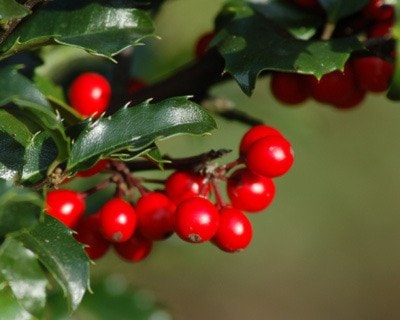by Brian Minter
Hardy winter colour is a garden ‘must have,’ and the new hardy, early blooming varieties of Christmas Rose (Helleborus niger) ‘Jacob” and ‘Josef Lemper’ top the list.
Their vibrant white blooms brighten any dark winter landscape, and they can even be used inside as cut flowers for a focal point on your Christmas table. Widely available, they’re in bloom now and make a wonderful living gift.
Winter berries add so much interest to a winter landscape. The most valuable is the deciduous winter holly called Ilex verticillata. Its stunning winter red berries are in high demand for wreaths, outdoor baskets and containers and for indoor centrepieces. I love the stems just as they are in a glass vase indoors or out on the patio. You need both male and female plants to get these beautiful bird-friendly berries, and today, good growers have planted both in one pot for immediate planting.
Wintergreen (Gautheria procumbens) is a beautiful low evergreen ground cover with rich deep green leaves, is almost continuous flowering and has edible red berries. Available in smaller pots, they make wonderful winter focal points in containers or as companions for white winter heather or Christmas roses.
Growing a little taller, a wonderful crab apple called Malus ‘Red Sentinel’ makes a great clean spring flowering screen or small shade tree. Its vibrant shiny large red fruits sparkle in winter. It’s like no other smaller tree as it’s loaded with hard fruits that are nice to enjoy on the tree, as cut branches in your outdoor décor or as a garnish on Christmas dinner plates. A frost or two will make them edible.
A prickly little plant that survives nicely outside in our toughest winters is a dwarf slow growing Butcher’s Broom (Ruscus ‘Christmas Berry’). It berries up nicely by itself, spreads slowly and beautifully complements any of its outdoor companions, like dwarf colourful conifers and low golden heathers. They look spectacular by themselves in clay pots with a few blueberry twigs tucked in.
Traditional holly trees have all but disappeared in our smaller space gardens and what a shame! To the rescue comes a new self-fertile, compact, hardy (zone 6) holly called ‘Red Beauty’. It grows only five to seven feet tall and four feet wide, making it a great focal point, container plant or a fabulous hedge. ‘Red Beauty’ presents a new opportunity for holly in the landscape. It’s a keeper!
Most camellias are rated as zone 7 plants and need a little protection in the coldest winter conditions. However, one stands out from all the rest. Camellia ‘Yuletide’ is a beauty. It’s a sasanqua camellia, which means it blooms from late November through April with pure red blooms that have vibrant yellow anthers. Talk about ‘the’ Christmas outdoor plant. It celebrates Christmas all by itself.
Amaryllis has become the ‘hot’ plant. It is now popular as cut flowers used to celebrate the season. I love putting the stems inside a tall glass vase where they look so elegant and last a long while if kept cool.
The newest plant to adorn our indoors is the beautiful ardisia. We’ve grown these plants for a month now. The new growth has burst into soft green leaves that make a nice contrast to the rich dark ones and to the delightful red berries that adorn the lower portion of the plant. Ardisias are going to be a winter classic for years to come – so watch out, poinsettias!
Finding a true Christmas cactus that most of our grandmothers had in their homes 50 years ago is hard, but not impossible. Schlumbergera bridgesii is a smooth-leafed cactus with hot-pink flowers that actually bloom only at Christmas. It’s an heirloom plant that is so easy to grow and is handed down from generation to generation. Start a new tradition in your family this year.
Another wonderful old tradition is to have ‘Paperwhite’ narcissus in our homes for the holiday season. Some people, have a love-hate relationship with the spectacular perfume of ‘Paperwhites.’ Like amaryllis, their long flower stems look stunning in a tall clear glass vase. You can still pick up bulbs that will bloom for the holidays if you keep them cool in a fancy glass dish with water and some colourful stones on the bottom, and started plants are always available at this time of year.
If you do any Christmas cooking, bay leaves are a must-have to flavour meats. We have a ten footer outside our door that we enjoy both as a landscape plant and as a source of fresh leaves all year round. Cut stems add interest and fragrance to Christmas wreaths.
They’re a little hard to find at this time of year, but herb growers have them. Treat it as a cool winter loving plant that needs to be outdoors all year round with a little winter protection in severe cold.
It could become one of your most-loved garden plants.
Brian Minter's column appears throughout the Lower Mainland. Contact him at newsroom@abbynews.com.
